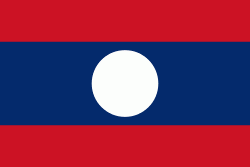Lao language
Lao, sometimes referred to as Laotian (ລາວ, 'Lao' or ພາສາລາວ, 'Lao language'), is a Kra–Dai language of the Lao people. It is spoken in Laos, where it is the official language for around 7 million people, as well as in northeast Thailand, where it is used by around 23 million people, usually referred to as Isan. Lao serves as a lingua franca among the citizens of Laos, who also speak approximately 90 other languages, many of which are unrelated to Lao.
It is a tonal and analytic language, similar to other Kra-Dai languages as well as to Chinese and Vietnamese. Spoken Lao is mutually intelligible with Thai and Isan, fellow Southwestern Tai languages, to such a degree that their speakers are able to effectively communicate with one another speaking their respective languages. These languages are written with slightly different scripts but are linguistically similar and effectively form a dialect continuum.
Although there is no official standard, the Vientiane dialect became the de facto standard language in Lao PDR, and the Khonkaen dialect became the de facto standard language in Isan in the second half of the 20th century.
The Lao language falls within the Lao-Phuthai group of languages, including its closest relatives, Phuthai (BGN/PCGN Phouthai) and Tai Yo. Together with Northwestern Tai—which includes Shan, Ahom and most Dai languages of China, the Chiang Saen languages—which include Standard Thai, Khorat Thai, and Tai Lanna—and Southern Tai form the Southwestern branch of Tai languages. Lao (including Isan) and Thai, although they occupy separate groups, are mutually intelligible and were pushed closer through contact and Khmer influence, but all Southwestern Tai languages are mutually intelligible to some degree. The Tai languages also include the languages of the Zhuang, which are split into the Northern and Central branches of the Tai languages. The Tai languages form a major division within the Kra-Dai language family, distantly related to other languages of southern China, such as the Hlai and Be languages of Hainan and the Kra and Kam-Sui languages on the Chinese Mainland and in neighbouring regions of northern Vietnam.
It is a tonal and analytic language, similar to other Kra-Dai languages as well as to Chinese and Vietnamese. Spoken Lao is mutually intelligible with Thai and Isan, fellow Southwestern Tai languages, to such a degree that their speakers are able to effectively communicate with one another speaking their respective languages. These languages are written with slightly different scripts but are linguistically similar and effectively form a dialect continuum.
Although there is no official standard, the Vientiane dialect became the de facto standard language in Lao PDR, and the Khonkaen dialect became the de facto standard language in Isan in the second half of the 20th century.
The Lao language falls within the Lao-Phuthai group of languages, including its closest relatives, Phuthai (BGN/PCGN Phouthai) and Tai Yo. Together with Northwestern Tai—which includes Shan, Ahom and most Dai languages of China, the Chiang Saen languages—which include Standard Thai, Khorat Thai, and Tai Lanna—and Southern Tai form the Southwestern branch of Tai languages. Lao (including Isan) and Thai, although they occupy separate groups, are mutually intelligible and were pushed closer through contact and Khmer influence, but all Southwestern Tai languages are mutually intelligible to some degree. The Tai languages also include the languages of the Zhuang, which are split into the Northern and Central branches of the Tai languages. The Tai languages form a major division within the Kra-Dai language family, distantly related to other languages of southern China, such as the Hlai and Be languages of Hainan and the Kra and Kam-Sui languages on the Chinese Mainland and in neighbouring regions of northern Vietnam.
Country
-
Laos
Laos, officially the Lao People's Democratic Republic (Lao: ສາທາລະນະລັດ ປະຊາທິປະໄຕ ປະຊາຊົນລາວ, French: République démocratique populaire Lao), is a socialist state and the only landlocked country in Southeast Asia. At the heart of the Indochinese Peninsula, Laos is bordered by Myanmar and China to the northwest, Vietnam to the east, Cambodia to the southeast, and Thailand to the west and southwest. Its capital and largest city is Vientiane.
Present-day Laos traces its historic and cultural identity to Lan Xang, which existed from the 13th century to the 18th century as one of the largest kingdoms in Southeast Asia. Because of its central geographical location in Southeast Asia, the kingdom became a hub for overland trade and became wealthy economically and culturally. After a period of internal conflict, Lan Xang broke into three separate kingdoms: Luang Phrabang, Vientiane and Champasak. In 1893, the three territories came under a French protectorate and were united to form what is now known as Laos. It briefly gained independence in 1945 after Japanese occupation but was re-colonised by France until it won autonomy in 1949. Laos became independent in 1953, with a constitutional monarchy under Sisavang Vong. A post-independence civil war began, which saw the communist resistance, supported by the Soviet Union, fight against the monarchy that later came under influence of military regimes supported by the United States. After the Vietnam War ended in 1975, the communist Pathet Lao came to power, ending the civil war. Laos was then dependent on military and economic aid from the Soviet Union until its dissolution in 1991.
